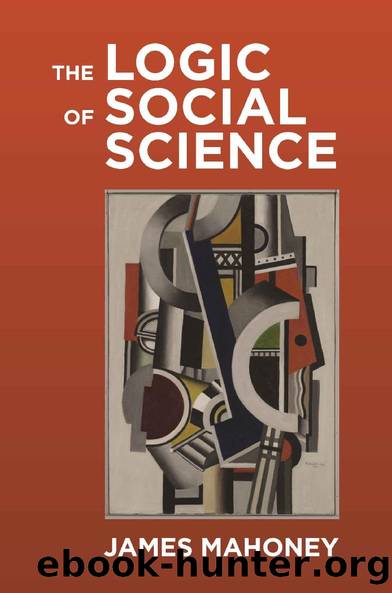The Logic of Social Science by James Mahoney

Author:James Mahoney [Mahoney, James]
Language: eng
Format: epub
ISBN: 9780691217055
Publisher: Princeton University Press
Published: 2021-08-16T21:00:00+00:00
THREE BASIC THEORY FRAMES
In the social sciences, basic theory frames provide stylized understandings of the actors, rules, and resources that characterize societies. Different basic theory frames conceive these categories and their relationships in contrasting ways. Within each frame, however, the conceptions of these categories resonate with one another, allowing us to speak of a harmonic triad between the actors, rules, and resources of a particular theory frame (cf. Emirbayer and Mische 1998: 971â72). Just as one note may be dominant within a particular musical triad, so too with a basic theory frame: one of the componentsâactors, rules, or resourcesâcan be dominant with a particular frame.4
Table 8.1 summarizes three basic theory frames used in macrosocial research: culturalist, rationalist, and structuralist theory frames (cf. Lichbach and Zuckerman 1997, 2009). The frames present alternative idealized portraits of society and its components. These frames are basic in the sense that they are formulated at a level of generality that is cognitively resonant and easily grasped by social scientists. Above this level, one finds general theoretical categories and relationships. For example, situated at this higher level are classic tensions in social theory, such as agency versus structure, idealism versus materialism, and integration versus disintegration. Below the basic level, one finds specialized theory frames, including specific subtypes of the basic theory frames. For example, social choice theory is a specialized theory frame within the basic rationalist frame; state-centered theory is a specialized theory frame within the basic structuralist frame; and social role theory is a specialized theory frame within the basic culturalist frame.
The three basic theory frames all posit interdependent relationships among actors, resources, and rules. As figure 8.1 illustrates, however, each frame calls special attention to the relationships corresponding to its dominant category. For each frame, one category strikes a dominant note in the triad. Thus, the culturalist theory frame especially emphasizes the ways in which social rules shape actors and resources; the rationalist theory frame stresses the ways in which actors shape social rules and resources; and the structuralist theory frame calls special attention to the ways in which resources shape actors and rules.
TABLE 8.1. A Stylized Typology of Theory Frames
Download
This site does not store any files on its server. We only index and link to content provided by other sites. Please contact the content providers to delete copyright contents if any and email us, we'll remove relevant links or contents immediately.
Machine Learning at Scale with H2O by Gregory Keys | David Whiting(4183)
Killers of the Flower Moon by David Grann(3969)
Oathbringer (The Stormlight Archive, Book 3) by Brandon Sanderson(2881)
Will by Will Smith(2793)
Once Upon a Broken Heart by Stephanie Garber(2670)
Guns, Germs and Steel by Diamond Jared(2303)
Borders by unknow(2229)
It Starts With Us (It Ends with Us #2) by Colleen Hoover(2198)
Friends, Lovers, and the Big Terrible Thing by Matthew Perry(2119)
The Room Where It Happened by John Bolton;(2103)
The Color of Law by Richard Rothstein(1885)
HBR's 10 Must Reads 2022 by Harvard Business Review(1777)
The Strength In Our Scars by Bianca Sparacino(1776)
A Short History of War by Jeremy Black(1762)
Water Rights and the Environment in the United States by John Burch(1643)
Examples & Explanations: Administrative Law by William F. Funk & Richard H. Seamon(1601)
515945210 by Unknown(1599)
A Game of Thrones (The Illustrated Edition) by George R. R. Martin(1589)
That Every Man Be Armed by Stephen P. Halbrook(1548)
